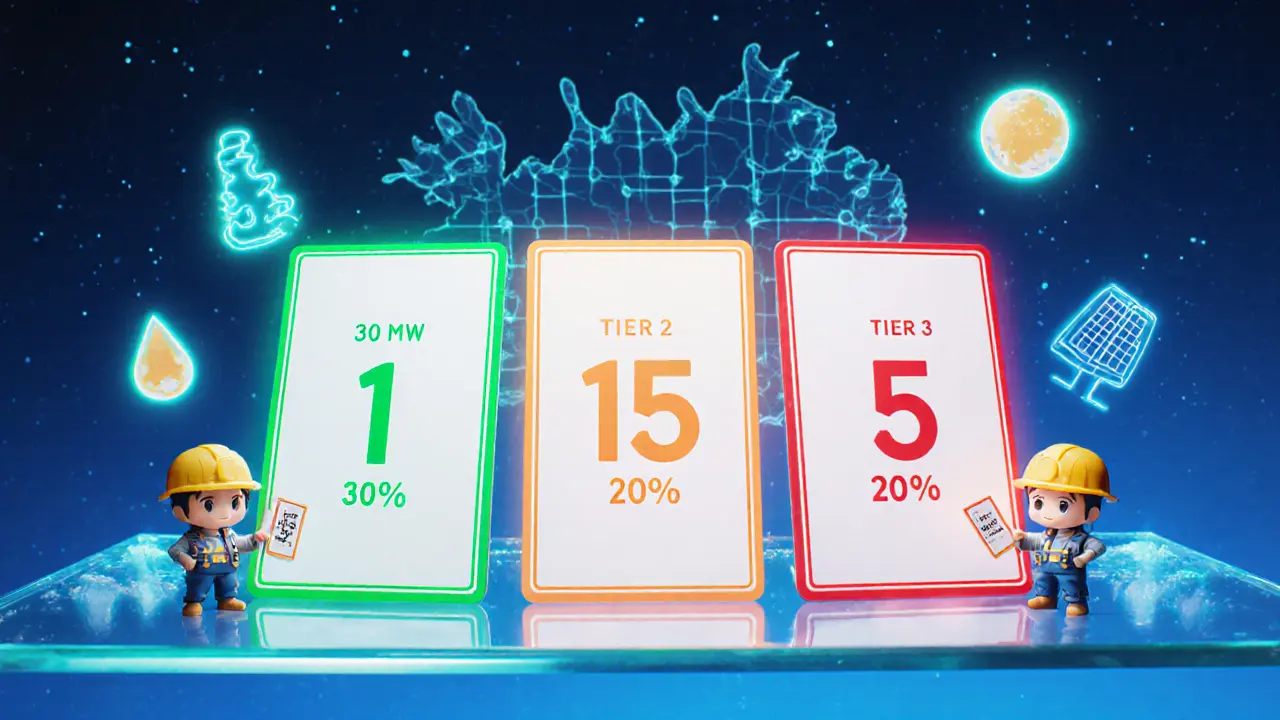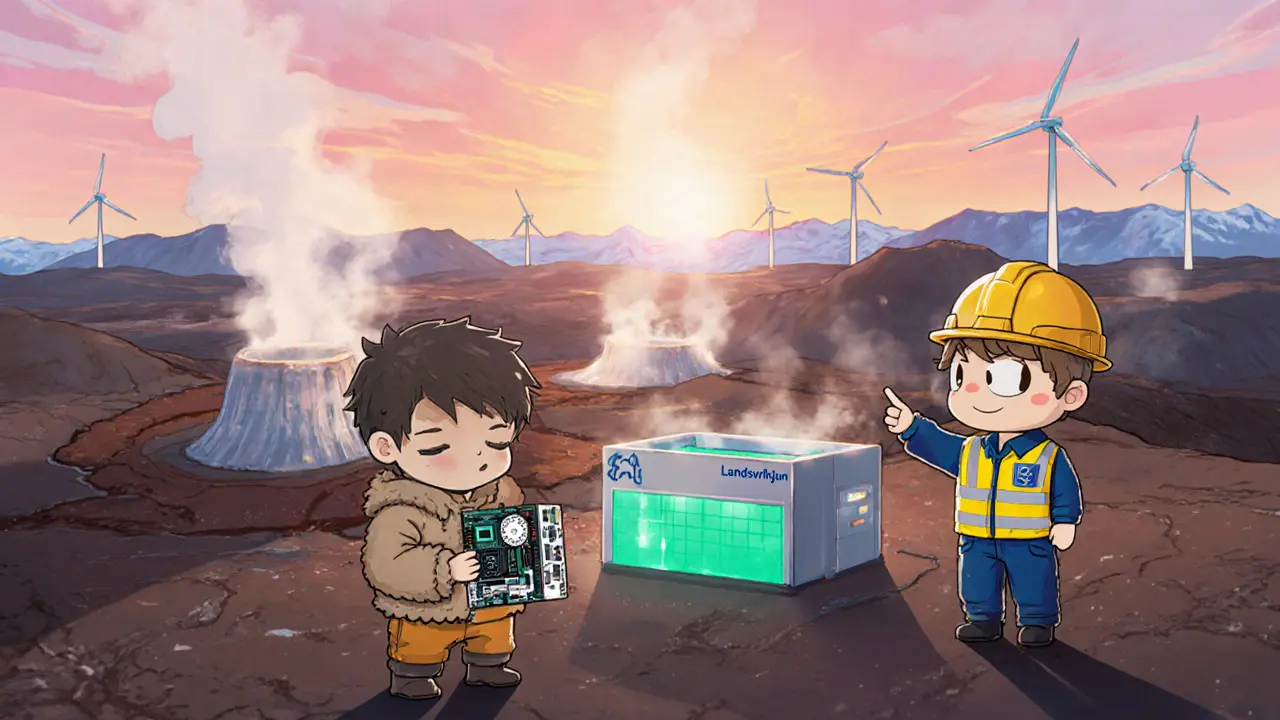Iceland Crypto Mining Tier Calculator
Your Mining Operation Tier
Green-Only
100% renewable source required
Up to 30 MW per site
Mixed
At least 80% renewable
Up to 15 MW per site
Restricted
Exceeds 15 MW or >50% non-renewable
Max 5 MW with curtailment
Key Takeaways
- Iceland’s national power company, Landsvirkjun, has introduced new caps on electricity allocated to crypto mining farms.
- Restrictions target high‑consumption operations, forcing miners to prove renewable‑only usage or face reduced supply.
- Energy‑intensive miners such as Hive Blockchain and Genesis Mining are already re‑configuring hardware to stay compliant.
- Regulators are pairing these utility‑level limits with broader financial‑supervisory rules to curb illegal activity.
- The policy shift aims to protect Iceland’s grid, keep power affordable for residents, and preserve the country’s green‑energy reputation.
When you hear "Iceland crypto mining restrictions" it usually brings up images of frigid farms buzzing behind volcanic hills. The reality is a bit more bureaucratic: the country’s national power company has started to police how much juice crypto farms can draw. This move follows years of headlines about miners gulping more electricity than the entire Icelandic population. Below you’ll find a step‑by‑step look at what the restrictions are, why they matter, and how miners can keep operating without getting shut off.
Landsvirkjun is Iceland’s national power company, responsible for generating and transmitting the bulk of the nation’s geothermal and hydroelectric electricity. In early 2025 the utility announced a three‑pronged framework that directly affects crypto mining facilities.
Why Iceland Became a Crypto Mining Magnet
Two natural advantages turned the island into a mining hotspot:
- Abundant geothermal energy heat‑derived power that accounts for roughly 65% of Iceland’s electricity mix. Cheap, stable, and carbon‑light.
- Arctic air that cools ASIC rigs for free, slashing cooling‑costs that would otherwise require expensive HVAC systems.
By 2023, mining farms were responsible for about 90% of the country’s data‑center electricity use. The cheap power attracted big players like Hive Blockchain Technologies a Canadian‑listed miner with a major Icelandic operation and Genesis Mining one of the world’s largest cloud‑mining providers. Their presence helped boost Iceland’s GDP after the 2008 financial crisis, but it also strained the grid.
What Prompted the New Restrictions?
In March2024, Katrín Jakobsdóttir the Prime Minister of Iceland, who has been vocal about sustainable energy policy publicly warned that mining was eating more power than the entire nation’s residential demand. Simultaneously, the Icelandic Financial Supervisory Authority the regulator overseeing crypto exchanges and anti‑money‑laundering compliance started tightening AML reporting for mining firms.
These political and financial signals forced Landsvirkjun to act. The utility’s concern wasn’t just about energy- it also worried about environmental impact. Even though the power is renewable, the sheer volume of consumption raises questions about preserving the island’s pristine ecosystems and keeping electricity prices low for locals.
The Three‑Tier Restriction Framework
Effective 1July2025, Landsvirkjun rolled out the following rules:
| Tier | Criteria | Power Allocation Limit | Compliance Requirement |
|---|---|---|---|
| Tier1 - Green‑Only | Facilities must prove 100% renewable source via real‑time metering | Up to 30MW per site | Submit quarterly renewable‑energy certificates (RECs) |
| Tier2 - Mixed | At least 80% renewable, 20% allowed from backup grid | Up to 15MW per site | Annual audit of fuel mix and emissions report |
| Tier3 - Restricted | Any site exceeding 15MW or using >50% non‑renewable | Maximum 5MW, subject to nightly curtailment | Apply for special permit; may be reduced during peak demand |
The utility also introduced a “real‑time load‑shedding API” that lets mining farms monitor available capacity minute‑by‑minute. If the national grid hits 95% utilization, the API automatically throttles power to Tier3 sites.

How Miners Are Responding
Big players have already taken action:
- Hive Blockchain announced a migration of 10MW of its hash‑rate to a new “green‑only” data hall that runs exclusively on geothermal steam.
- Genesis Mining is retrofitting older ASICs with more energy‑efficient chips, cutting its per‑hash electricity use by roughly 12%.
- Bitfury Holding filed for a Tier2 permit and is now purchasing RECs from a local wind farm to boost its renewable share.
Smaller farms are either selling excess capacity back to the grid or shutting down during winter peaks when hydro reservoirs dip.
Impact on Iceland’s Energy Landscape
The restrictions are expected to shave~7GW‑hours per year off the national load, enough to keep household electricity prices flat for 2026. More importantly, the policy preserves the country’s renewable energy mix of geothermal and hydroelectric power that powers over 95% of Icelandic homes reputation.
Environmental NGOs have welcomed the move, noting that reduced mining demand lowers the need for new geothermal wells, which can alter fragile volcanic aquifers.
Legal and Financial Oversight
Beyond the utility caps, the Icelandic Financial Supervisory Authority now requires:
- Proof of AML compliance for every mining operator with a turnover above €5million.
- Annual disclosure of energy consumption and source breakdown.
- Registration of any cross‑border crypto‑related transactions over €10,000.
Failure to comply can result in fines up to 5% of annual revenue and possible revocation of the mining license.
What This Means for Prospective Miners
If you’re thinking of setting up a farm in Iceland in 2025 or later, here’s a quick checklist:
- Calculate expected power draw and see which tier you fall into.
- Secure a renewable‑energy certificate package before the first power draw.
- Integrate the Landsvirkjun load‑shedding API into your monitoring stack.
- Prepare AML documentation for the Financial Supervisory Authority.
- Consider co‑locating with an existing Tier1 facility to share infrastructure.
Skipping any of these steps could lead to abrupt power cuts, especially during the summer tourism surge when the grid is already near capacity.
Future Outlook: From Mining to Blockchain Innovation
While mining faces tighter constraints, Iceland is pivoting toward broader blockchain uses. The Central Bank is exploring a central bank digital currency (CBDC) pilot, and the government is funding research into decentralized finance (DeFi) platforms that run on low‑energy proof‑of‑stake chains.
In this environment, companies that can combine energy efficiency with regulatory compliance will likely secure the next wave of public‑sector contracts, such as digital identity services or secure voting systems.

Frequently Asked Questions
What is the main purpose of Landsvirkjun’s new restrictions?
The goal is to limit the amount of electricity that high‑consumption crypto mines can use, protect grid stability, keep power affordable for residents, and maintain Iceland’s green‑energy image.
Can existing mining farms stay operational under the new rules?
Yes, but they must either prove 100% renewable sourcing to qualify for Tier1, reduce their power draw to fit Tier2 limits, or accept curtailment under Tier3. Most large operators are already upgrading hardware or purchasing RECs.
How does the load‑shedding API work?
The API publishes real‑time grid utilization data. When the threshold (95% capacity) is reached, it sends a signal that automatically throttles power to Tier3 sites, preventing a total blackout.
Are there financial penalties for non‑compliance?
The Financial Supervisory Authority can levy fines up to 5% of annual revenue, and Landsvirkjun can cut power supply or revoke the mining permit entirely.
Is Iceland still a good place for crypto mining?
It remains attractive for low‑cost renewable energy, but miners must now operate within stricter caps. Companies that adapt quickly will retain the advantage, while those that ignore the rules risk shutdowns.
Bottom line: Iceland’s national power company has put a leash on crypto mining, but the leash is designed to keep the industry alive in a sustainable way. By understanding the three‑tier system, proving renewable usage, and staying on the regulator’s good side, miners can continue to profit from the island’s cold climate and cheap power without causing a national blackout.




Briana Holtsnider
July 8, 2025 AT 09:38Looks like the new tier system is just a sugar‑coated excuse for the grid to keep greedy miners in check. The renewable percentage thresholds are arbitrarily set, and the 5 MW cap on Tier 3 feels like a punitive measure rather than a genuine sustainability push. In practice, this will push smaller operations out of the market, consolidating power in the hands of the big players who can afford the compliance paperwork. It's a classic case of policy masquerading as environmental stewardship while protecting existing interests.
Corrie Moxon
July 12, 2025 AT 05:28Hey folks, this is a solid step forward for Iceland’s energy future. If miners adapt quickly, they’ll still reap the benefits of cheap, green power without jeopardizing the grid. Think of it as a chance to innovate on efficiency and showcase how crypto can coexist with renewable goals. Keep the optimism alive, and the community will find ways to make it work.
Jeff Carson
July 16, 2025 AT 01:17Interesting how the API will throttle Tier 3 sites in real‑time – that’s a clever tech solution, and it gives miners a clear signal when to scale back. It also encourages everyone to push for higher renewable shares, which aligns with the green‑only vision. :) The tier calculator is a handy tool, so I’d suggest running a few scenarios before committing to any hardware upgrades.
Anne Zaya
July 19, 2025 AT 21:07Honestly, I think Iceland’s vibe stays chill even with these rules. It’s just another layer of bureaucracy, but the country’s still blessed with cheap geothermal and hydro. If you’re smart about where you set up, you’ll still get a sweet deal. Just remember to keep an eye on the load‑shedding alerts.
Emma Szabo
July 23, 2025 AT 16:56Wow, talk about a regulatory rainbow! 🌈 The tier system paints a vivid picture: Tier 1 is the emerald forest of pure green, Tier 2 the amber sunrise of mixed energy, and Tier 3 the stormy gray of curtailment. Mining outfits that sprint toward the green finish line will sparkle like fireworks over Reykjavik. Those who linger in the shadows risk being dimmed by the grid’s night‑time cap. Embrace the challenge, and you’ll turn constraints into a dazzling showcase of eco‑innovation.
Fiona Lam
July 27, 2025 AT 12:45What the heck? They’re basically telling miners to get their act together or get the boot. This “real‑time load‑shedding API” is just a big way to police us all the time. If you can’t handle a few minutes of throttling, maybe crypto mining isn’t for you. Stop whining and upgrade your rigs.
OLAOLUWAPO SANDA
July 31, 2025 AT 08:35I don’t see why Iceland has to limit anyone. The world needs crypto power, and they have the resources. If they want more profit, they should open the grid wider, not cut us down.
Alex Yepes
August 4, 2025 AT 04:24Dear community, the recent policy articulates a meticulous approach to energy allocation, meticulously balancing renewable integration with grid reliability. It delineates three distinct tiers, each accompanied by quantitative thresholds and corresponding operational mandates. While Tier 1 mandates a 100% renewable portfolio and caps at 30 MW, Tier 2 permits a minimum of 80% renewables with a 15 MW ceiling. Tier 3, conversely, subjects operations exceeding 15 MW or possessing over 50% non‑renewable input to stringent curtailment provisions, limiting output to a maximum of 5 MW. The incorporation of a real‑time load‑shedding API epitomizes the proactive governance model, ensuring instantaneous mitigation of grid stress. Stakeholders are thus impelled to align their strategic planning with these parameters to sustain operational continuity.
Sumedha Nag
August 8, 2025 AT 00:14Honestly, these restrictions sound like a joke. If miners really cared about sustainability they'd move elsewhere, not fight the rules. Iceland should just let the market decide and keep the cash flowing.
Holly Harrar
August 11, 2025 AT 20:03Sure thing! Just remember to get your RECs sorted before you flip the switch, otherwise you’ll be in hot water with the authority. Definately check the API docs so you don’t get surprised by a sudden power cut. It’s not rocket science, just a bit of paperwork.
Vijay Kumar
August 15, 2025 AT 15:52From my perspective, the tier system could actually push the industry toward better tech. If you’re a smaller farm, consider co‑locating with a Tier 1 operator to share geothermal steam – that cuts costs and keeps you under the cap. At the same time, don’t ignore the seasonal dip in hydro capacity; plan for a backup source or schedule downtime during peak tourism months. It’s a balancing act, but doable.
Edgardo Rodriguez
August 19, 2025 AT 11:42Well, consider this: the tiered framework, while ostensibly straightforward, actually introduces a multilayered matrix of compliance requirements, each of which must be meticulously documented, verified, and reported-otherwise, the resulting penalties could be severe; consequently, operators are advised to adopt a holistic strategy, integrating real‑time monitoring, renewable certificate acquisition, and proactive stakeholder communication.
mudassir khan
August 23, 2025 AT 07:31Frankly, the whole policy is a superficial veneer, designed to placate environmental NGOs while preserving the status quo; the thresholds are arbitrary, the enforcement mechanisms are vague, and the penalties, though technically severe, are unlikely to be applied consistently, rendering the entire exercise a farce.
Bianca Giagante
August 27, 2025 AT 03:21It’s understandable that stakeholders have differing concerns; on one hand, the grid must remain stable, and on the other, miners need certainty-therefore, a collaborative dialogue, perhaps through a joint advisory panel, could harmonize objectives and mitigate friction.
Andrew Else
August 30, 2025 AT 23:10Oh great, another “green” regulation that will probably just become a paperwork nightmare.
Susan Brindle Kerr
September 3, 2025 AT 19:00Behold the grandiloquent proclamation of sustainability! Iceland, bathed in ethereal geothermal mist, now dons a cloak of regulatory grandeur, daring the crypto titans to bow before its verdant throne. Yet beneath the poetic veneer lies a relentless calculus, mercilessly pruning those who cannot appease the elemental gods.
Jared Carline
September 7, 2025 AT 14:49While the authorities commend their “green‑only” ambition, one must question whether such stringent caps truly serve the national interest; perhaps a more liberal allocation, calibrated to fiscal imperatives, would better sustain the island’s economic vitality.
raghavan veera
September 11, 2025 AT 10:38Ever think about how power itself is a metaphor for control? The load‑shedding API is like a digital governor, reminding us that even in blockchain’s decentralized dream, there are still invisible hands steering the flow.
Danielle Thompson
September 15, 2025 AT 06:28Keep pushing forward, you’ve got this! 🚀
Eric Levesque
September 19, 2025 AT 02:17If Iceland wants to stay strong, it should let miners run free and make the most of its natural power.
alex demaisip
September 22, 2025 AT 22:07The recent tiered restriction framework introduced by Landsvirkjun constitutes a multi‑dimensional regulatory schema that intersects energy economics, blockchain operational design, and compliance engineering. Firstly, the delineation of Tier 1, Tier 2, and Tier 3 establishes quantitative thresholds for renewable energy share and absolute megawatt capacity, thereby enforcing a tiered elasticity model. Secondly, the integration of a real‑time load‑shedding API operates as an automated feedback loop, ingesting grid utilization metrics and issuing throttling commands to mining endpoints when the 95% utilization threshold is breached. Thirdly, the mandatory procurement of Renewable Energy Certificates (RECs) functions as a market‑based mechanism to offset non‑renewable consumption, effectively creating a tradable asset for compliance. Fourthly, the financial oversight provisions stipulated by the Icelandic Financial Supervisory Authority impose AML documentation, annual energy disclosure, and cross‑border transaction reporting, thereby aligning the sector with broader anti‑money‑laundering frameworks. Fifthly, the penalty matrix-capped at 5% of annual revenue or license revocation-introduces a risk‑adjusted cost function that must be incorporated into the total cost of ownership model for mining hardware. Moreover, the curtailment provisions for Tier 3 operators, which limit output to a maximum of 5 MW under peak conditions, necessitate dynamic load‑balancing algorithms within the mining software stack. In practice, operators must therefore architect a hybrid infrastructure that couples high‑efficiency ASICs with predictive analytics to forecast load‑shedding events. Additionally, the requirement to co‑locate with existing Tier 1 facilities encourages the formation of energy‑sharing consortia, which can achieve economies of scale in geothermal steam utilization. The regulatory environment also incentivizes the adoption of proof‑of‑stake or other low‑energy consensus mechanisms for future blockchain projects, as the marginal cost of PoW mining continues to rise under the caps. Consequently, strategic capital allocation decisions now incorporate not only hash‑rate considerations but also regulatory compliance trajectories. Finally, the policy’s emphasis on preserving Iceland’s renewable image aligns with global ESG investment trends, potentially unlocking additional financing channels for compliant mining entities. In summary, the confluence of technical, economic, and legal dimensions creates a complex optimization landscape that forward‑looking operators must navigate to maintain profitability and regulatory standing.
Elmer Detres
September 26, 2025 AT 17:56Wow, that was an impressive deep‑dive! It really drives home how much forethought is needed to stay ahead of the curve. I’d add that maintaining a strong community dialogue can help smooth the inevitable bumps in the compliance road.
Tony Young
September 30, 2025 AT 13:45Picture this: a mining farm humming quietly under the aurora, its fans whispering thanks to a well‑tuned load‑shedding script. By syncing your ASIC firmware to the API’s heartbeat, you turn potential blackouts into graceful pauses, preserving hardware longevity and profit margins. It’s not just about surviving the caps; it’s about thriving within them.
Fiona Padrutt
October 4, 2025 AT 09:35Let’s be real-if Iceland wants to keep its energy cheap and green, it should let the miners keep the lights on and the economy humming. The policy is fine, but don’t over‑regulate; give us the room to innovate and the country will reap the rewards.